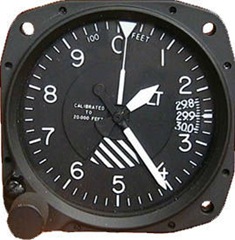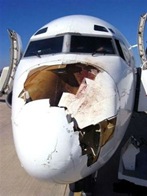Muhammad Ali: Superman don’t need no seat belt.
Flight Attendant: Superman don’t need no airplane, either.
— quoted by Clifton Fadiman, ‘The Little, Brown Book of Anecdotes,’ 1985.
Golf Hotel Whiskey: for pilots and aviation enthusiasts
Muhammad Ali: Superman don’t need no seat belt.
Flight Attendant: Superman don’t need no airplane, either.
— quoted by Clifton Fadiman, ‘The Little, Brown Book of Anecdotes,’ 1985.
General Aviation News will often reprint US National Transportation Safety Board (NTSB) accident reports, including one dated January 2011 where incorrect altimeter settings during a night landing in a Cessna 172 in Clarendon (Texas) that led to serious injuries and substantial damage to the aircraft involved.
 According to the accident report, the pilot was attempting a night landing and he saw the airport’s rotating beacon. However, he was unable to activate the runway lights. Nevertheless, the pilot maneuvered the aircraft onto the downwind leg of the traffic pattern, extended the flaps, reduced engine power and pancaked into the ground about two and a half miles from the airport.
According to the accident report, the pilot was attempting a night landing and he saw the airport’s rotating beacon. However, he was unable to activate the runway lights. Nevertheless, the pilot maneuvered the aircraft onto the downwind leg of the traffic pattern, extended the flaps, reduced engine power and pancaked into the ground about two and a half miles from the airport.
During the investigation, the pilot told investigators he was at 900 feet AGL when he hit the ground on terrain that was approximately 2,800 feet MSL while the altimeter at the crash site read 7,500 feet MSL. Had the altimeter been set correctly, it should have read 3,700 feet MSL at 900 feet AGL.
In the comments section, Vaughn S. Price made the suggestion:
…keep your cockpit lights low when making a dark field approach keep your eyes on your surroundings, then the altimeter reading would not dictate your actions.
In addition, Russell P Craig CFIAIG wrote that he experienced a similar situation when he was a younger pilot where the lights would not come on:
I remembered that some of the older pilots talked about lining up with some of the hangar lights when the runway lights didn’t work. I tryed that and when a barn an trees showed up in my landing lights I went around. Scared me and from that time on I always circled the airport at night to make sure where I was.
In other words, don’t rely entirely on your altimeter to tell you when you are flying at a safe altitude and try to circle the airport at least once if you are doing a night landing where there is no tower or ATC to guide you.
NBC in the states is reporting that military flyovers at American sporting events are about to become a thing of the past thanks to the “sequester” budget cuts with a March 10 flyover at the NASCAR races in Las Vegas being the last one scheduled:
Breaking sports news video. MLB, NFL, NBA, NHL highlights and more.
As you can imagine, the video segment posted on Yahoo! sports about cutting military flyovers has attracted a number of entertaining comments (more than 4,000 and counting), with some of the most popular comments right now being:
And yet we will send $1 billion and new F16s to Egypt, a country that hates us. Idiotic.
And:
Gosh, how many years did it take the brain child’s in DC to figure this out. Now, time to cut back on all the wasted "flyovers" of Air Force 1 too.
And:
What’s next? Ending the Space Shuttle Program? Oh … wait. At least we will always keep minting pennies which cost the govt 2 cents to make.
So it looks like Americans will have to travel to Britain to see military flyovers at special British events!
If you have ever wondered why commercial passengers planes have round windows, Channel 4 recently aired “A Great British Air Disaster,” an excellent documentary chronicling the rise and fall of the De Havilland Comet and by default, the fall of British aviation and manufacturing.
The De Havilland Comet was conceived during World War II as the world’s first passenger jet airliner and it was an instant hit with the public when it came into service in 1952. However and in the space of just four months in 1954, two aircraft blew up in mid-air killing all aboard. The ensuing investigation into what caused the crashes led to the birth of modern aircraft crash investigations, round windows becoming standard on all aircraft to prevent metal fatigue and ultimately to the rise of Boeing.
Both the Guardian and the Telegraph have reviews of “A Great British Air Disaster” and if you missed it the first time, its scheduled to air again on Friday, March 1, at 1:10 am and 2:10 am. If you don’t want to wait up that late, you might want to keep an eye on YouTube as someone is bound to upload the documentary on there.
However, it appears that the full episode of “Seconds From Disaster – Comet Air Crash,” another documentary dating from 2006 about the De Havilland Comet crashes, is posted on YouTube and is well worth watching:
Leader, bandits at 2 o’clock!
Roger; it’s only 1:30 now—what’ll I do ‘til then?
— The Bill Waterson comic character Calvin, of ‘Cavin and Hobbes.’ fame.
The Hudson River incident a few years ago brought dramatic attention to the problem of aircraft bird strikes being all too common, but rarely deadly for aircraft. However, a group called the Bird Strike Committee USA has an article on its website entitled “The Top 10 Bird Strike Myths” and some of the following myths exposed may be somewhat startling.
Obviously the answers are the opposite of the above statements or myths and the Bird Strike Committee USA’s article goes into considerable detail listing all of the facts about  bird strikes for each one. The Bird Strike Committee USA’s main website also points out that annual bird and other wildlife strikes to aircraft cause well over $600 million in damage to US civil and military aviation and that over 219 people have been killed worldwide since 1988 (click here to see their list of bird strike incidents starting with Orville Wright).
bird strikes for each one. The Bird Strike Committee USA’s main website also points out that annual bird and other wildlife strikes to aircraft cause well over $600 million in damage to US civil and military aviation and that over 219 people have been killed worldwide since 1988 (click here to see their list of bird strike incidents starting with Orville Wright).
It should be mentioned that the Bird Strike Committee USA was formed in 1991 to address bird strike issues and their next annual meeting is scheduled for August in Milwaukee, Wisconsin. Such meetings are usually spread out over 3 1/2 days and include four parts:
If you are an airport official in the UK and can’t attend one of these annual meetings, the Bird Strike Committee USA’s website has an Understanding and Reducing Bird Hazards to Aircraft page and a Best Management Practices For Airport Wildlife Control paper listing some of the steps you can take to reduce wildlife dangers at or around airports.